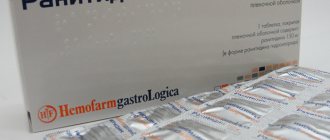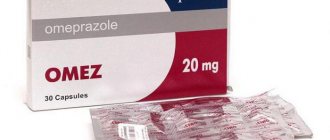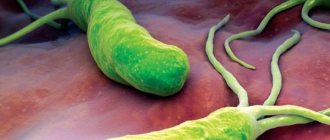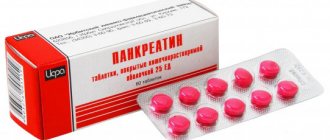- May 31, 2019
- Gastroenterology
- Savelyeva Victoria
Ranitidine is a medicine belonging to the group of H2 receptor antagonists. It blocks the secretion of acid and pepsin in the stomach. Let's find out how to properly take 150 mg and 300 mg tablets of this drug, according to the instructions, in the presence of stomach and duodenal ulcers, as well as heartburn.
In what form of release can the drug be found on sale?
Ranitidine stomach tablets are intended for oral administration and are enteric-coated. They have a round shape, a biconvex surface, and are light orange in color. The main active ingredient of the drug is ranitidine hydrochloride; one tablet contains 150 and 300 mg.
The auxiliary components are titanium dioxide, corn starch, propylene glycol, sunset yellow dye, ethylcellulose, microcrystalline cellulose, polyethylene glycol 6000, sodium lauryl sulfate, magnesium stearate. The Ranitidine package contains several blisters with 10 tablets. The cardboard box contains instructions for using the medicine.
Release form and composition
Ranitidine has several trade names, with Zantac being one of the most popular. There are several releases of this drug:
- Solution for injection - can be used in a hospital setting, as it is injected into a vein. Externally, the solution is colorless or light yellow. This form ensures the fastest action of the drug.
- Tablets of 150 and 300 mg, white, film-coated. A widely used form of release of ranitidine: tablets are easy to use and do not require special training or supervision of medical personnel.
- Effervescent round tablets from light yellow to white for the preparation of a drink, 150 and 300 mg.
Each form implies the presence of additional components in addition to the active substance. They are needed to impart taste and the desired consistency, stabilize the active substance and extend the shelf life of the medicine.
Pharmacological properties
According to the instructions for use, Ranitidine belongs to the antiulcer drugs from the group of histamine H2 receptor antagonists. It selectively blocks histamine H2 receptors of parietal cells in the gastric mucosa and inhibits the production of hydrochloric acid. The total volume of secretion becomes less under the influence of this drug, as a result of which the amount of pepsin in the stomach contents decreases. Thanks to the antisecretory effect, favorable conditions are created for the rapid healing of stomach and duodenal ulcers.
Against the background of taking the drug, there is an increase in protective factors in the tissues of the gastroduodenal zone: reparative processes are enhanced, microcirculation is improved, and the production of mucous substances is increased. Let's figure out why Ranitidine tablets help.
Ranitidine - what is it and why?
Ranitidine is a medicine that is used for diseases of the digestive tract.
Indications for the use of ranitidine are heartburn (what is this?), gastritis with high acidity, gastric and duodenal ulcers, erosive lesions, Zollinger-Ellison syndrome, etc.
The main effect of the drug is antisecretory: ranitidine helps block the production of hydrochloric acid by stomach cells by acting on histamine receptors.
The volume of gastric juice, as well as its acidity, decreases, and the pH level increases. Enzymes are protein compounds that are very dependent on temperature, acidity level and other environmental factors in the body. With an increase in pH, the activity of pepsin and a number of other gastric juice enzymes decreases, and their aggressive effect on the mucous membrane of the organ decreases.
The drug in modern medicine is considered relatively old and is rarely used.
Historically, ranitidine is the second antisecretory agent (after cimetidine) used to treat gastritis and peptic ulcers. Now there are new analogues of ranitidine that have fewer side effects and restrictions on use.
Area of use of the medicine
The main area of application of this drug is gastroenterology. On sale you can find such a drug as Ranitidine Akos. What does it help with? The medicine is prescribed for the treatment of various pathologies of the digestive system, and it can also be used for prevention. The indications of Ranitidine are described in detail in the instructions.
Indications for use
There is such a medicine in pharmacies as Ranitidine Acri. It is prescribed for symptomatic ulcerative lesions of the digestive tract; peptic ulcer of the digestive system (stomach, duodenum); Zollinger-Ellison syndrome; to prevent aspiration of gastric juice during surgical operations using anesthesia; to prevent the occurrence of “stress” ulcers; reflux esophagitis; erosive esophagitis; to prevent the formation of ulcerative lesions of the stomach and intestines after surgical interventions; for the prevention of recurrent bleeding from the upper digestive tract.
What are Ranitidine Sopharma tablets prescribed for? Indications for the use of this remedy are similar pathologies and conditions.
Directions for use and dosage
The tablets are taken orally, without chewing, swallowed whole and washed down with a small amount of water or other liquid, regardless of meals.
Recommended doses and duration of treatment with Ranitidine:
- Gastroesophageal reflux disease: 150 mg twice a day or 300 mg once (at night). If necessary, the dose is increased to 150 mg four times a day. Duration of therapy is 8-12 weeks. For long-term prevention – 150 mg twice a day;
- Ulcers caused by NSAIDs: 150 mg twice a day or 300 mg once (at night). Duration of therapy is 8-12 weeks. For prevention purposes - 150 mg twice a day;
- Zollinger-Ellison syndrome (gastrinoma): 150 mg three times a day, if necessary, the dose can be increased;
- Prevention of recurrent bleeding: 150 mg Ranitidine twice a day;
- Peptic ulcer of the duodenum and stomach: 150 mg twice a day or 300 mg once (at night) for exacerbations. If necessary, the dose is increased to 300 mg twice a day. Duration of therapy is 4-8 weeks. For prevention purposes, the drug is prescribed at night 150 mg (for smoking patients - 300 mg);
- Prevention of Mendelssohn's syndrome: 150 mg of Ranitidine 2 hours before general anesthesia and, if possible, 150 mg on the evening before surgery;
- Postoperative and “stress ulcers”: 150 mg twice a day, course – 4-8 weeks.
If liver function is impaired, dose adjustment may be required. For patients with renal failure (creatinine clearance less than 50 ml/min), it is recommended to prescribe Ranitidine at a dose of 150 mg per day.
How to use the medicine correctly?
Ranitidine, as already noted, is a tablet drug. The method of its use should be determined by a doctor. The usual daily dose is 75 mg for short-term relief from heartburn, and 300 mg for exacerbations of gastrointestinal ulcers. How to take Ranitidine correctly - before or after meals? Tablets are taken regardless of food; sometimes it is recommended to take them immediately after a meal or before bed.
How to use Ranitidine for heartburn? Self-treatment of this pathology is allowed for two weeks. If there is no improvement in the condition, it is better to consult a doctor for a medical examination. Long-term use of the medication without consultation with a specialist is prohibited.
How to take the remedy for gastric and duodenal ulcers? For the treatment of exacerbations, 150 mg is prescribed twice a day (in the morning and in the evening) or 300 mg at bedtime. If necessary, 300 mg twice a day. The course of therapy is continued for 4-8 weeks.
In order to prevent exacerbations, 150 mg is prescribed before bedtime, for smokers - 300 mg before bedtime.
An ulcer that occurs due to the use of non-steroidal anti-inflammatory drugs (NSAIDs) is also treated with the drug Ranitidine. It is usually prescribed 150 mg twice a day or 300 mg at bedtime, the course is continued for at least 8-12 weeks.
To prevent the occurrence of ulcers when taking NSAIDs - 150 mg twice a day.
In the presence of postoperative and “stress” ulcers, 150 mg of the drug is prescribed twice a day, treatment lasts 4-8 weeks. The dosage of Ranitidine must be strictly observed.
In the presence of erosive reflux esophagitis, 150 mg is prescribed twice a day or 300 mg at bedtime. If necessary, the dose is increased to 150 mg four times a day. The course of therapy lasts 8-12 weeks.
If long-term preventive therapy is needed, 150 mg is prescribed twice a day. How to take the drug for Zollinger-Ellison syndrome? The initial dosage is set as follows: 150 mg three times a day, if such a need arises, it is increased.
To prevent recurrent bleeding, 150 mg is prescribed twice a day. To prevent the development of Mendelssohn's syndrome, doctors prescribe the medication in a dose of 150 mg a couple of hours before anesthesia, in addition, they recommend taking 150 mg the evening before.
If concomitant liver impairment is present, the dose may need to be reduced. For renal failure with CC less than 50 ml/min, the optimal dosage would be 150 mg per day. This is confirmed by the instructions for use of Ranitidine.
Ranitidine
Ranitidine is an antagonist of H2-histamine receptors on parietal cells of the gastric mucosa and is used for various gastrointestinal pathologies, including ulcerative lesions of the gastric mucosa and duodenum. The drug inhibits basal (in the absence of any irritants) and stimulated, caused by exposure to any external factors, secretion of hydrochloric acid. The role of irritating factors that stimulate the release of HCl into the lumen of the stomach can be food intake, irritation of baroreceptors that perceive mechanical stretching of the gastric wall, the action of hormones and other biologically active substances (gastrin, pentagastrin, histamine). Ranitidine reduces the amount of gastric juice produced and the concentration of hydrochloric acid in it, reduces the acidity of the stomach, which entails the inactivation of the main proteolytic enzyme - pepsin, and inhibits the work of microsomal liver enzymes. The therapeutic effect of a single dose of ranitidine lasts for 12 hours.
Ranitidine can be taken at any time without regard to diet. The tablet is swallowed whole and washed down with a sufficient amount of water. In case of exacerbation of gastric ulcer and duodenal ulcer, incl. caused by taking NSAIDs, ranitidine is prescribed 150 mg in the morning and evening (the entire daily dose of the drug can be taken at one time before bedtime).
In severe cases, 300 mg twice a day can be taken. The duration of the therapeutic course is from 4 to 8 weeks. To prevent exacerbation of the disease, ranitidine is taken in an amount of 150 mg 1 time per day (for smokers, the dose is doubled because this human defect reduces the effectiveness of ranitidine).
A feature of ranitidine (as, in fact, other drugs of this pharmacological group) is the occurrence of withdrawal syndrome when the drug is abruptly stopped. This syndrome (also called rebound syndrome) leads to an exacerbation of all those symptoms of the disease that were previously suppressed by the drug. In this regard, the completion of the therapeutic course should be smooth.
The effectiveness of ranitidine can play a cruel joke on the patient in cases where the cause of dyspeptic disorders is much more serious. Therefore, before starting treatment, it is advisable to undergo examination by an oncologist to exclude the possibility of a malignant neoplasm in the stomach. Another important recommendation is a “taboo” while taking the drug on the consumption of food and drinks that can irritate the gastric mucosa.
Possible negative reactions of the body
In accordance with the instructions for use, Ranitidine can lead to:
- leukopenia (with long-term treatment);
- thrombocytopenia;
- atrioventricular block (if intravenous infusion is performed);
- bowel disorders (constipation/diarrhea syndrome);
- hepatitis (in very rare cases);
- vertigo, dizziness;
- fatigue;
- blurred vision;
- headaches;
- hallucinations (also in rare situations);
- confusion (very rare);
- increased prolactin levels;
- increased creatinine levels;
- amenorrhea;
- gynecomastia;
- decreased libido;
- impotence;
- recurrent mumps;
- arterial hypotension;
- bronchospasm;
- arthralgia;
- hair loss;
- anaphylactic shock;
- angioedema;
- hives;
- various skin rashes;
- myalgia.
How to take Ranitidine
Since patients with gastritis and ulcers most often take tablets, it is worth focusing on taking this particular form of ranitidine.
The drug is prescribed by a gastroenterologist after examination and an accurate diagnosis, after identifying conditions that may interfere with the prescription of this medicine.
Ranitidine tablets are taken regardless of food intake: they do not need to be chewed, they should simply be swallowed with a glass of plain water.
Dosages differ by age: for adults and children over 12 years of age, ranitidine, according to the instructions for use, is prescribed 0.15 g (1 tablet of 150 mg) 2 times a day - morning and evening. You can reduce the number of doses by taking one 300 mg tablet at night.
The course of treatment is long - on average 7-8 weeks. Ranitidine is also used to prevent the development of gastrointestinal bleeding in individual dosages. The duration of action of the medicine after a single dose is about 12 hours.
You cannot prescribe ranitidine to yourself after reading the instructions for use. There may be concomitant diseases that affect the extent of absorption and distribution of the drug in the body.
If a person has liver pathologies, it may be necessary to reduce the dosage or frequency of administration. This also applies to patients with kidney diseases: if there are impaired renal function, then you should choose the dosage with your doctor or give up ranitidine tablets altogether and choose another medicine.
Use by pregnant and lactating women
As the instructions for use tell us, Ranitidine should be used during pregnancy and lactation only after a strict assessment of the risks and benefits has been carried out. According to the experience of doctors and patients, this medication is well tolerated and does not cause harm to the baby. It can be considered the drug of choice for pregnant women. When breastfeeding, it is recommended to take Ranitidine only when the benefit outweighs the risk. Possible temporary disorders in the child cannot be completely excluded.
Drug interactions
Smoking reduces the effectiveness of the drug.
Ranitidine increases the concentration of metoprolol in the serum, inhibits the metabolism in the liver of diazepam, propracolol, lidocaine, theophylline, glipizide, metronidazole, phenazone, hexobarbital, phenytoin, aminophylline, buformin, aminophenazone, calcium antagonists and indirect anticoagulants.
When used simultaneously with ketoconazole and itraconazole, the absorption of the latter may be reduced.
There should be a break of at least 2 hours between taking ranitidine and sucralfate in high doses, as well as antacids.
Bone marrow suppressant drugs, when used concomitantly with ranitidine, increase the likelihood of developing neutropenia.
What to replace the drug with if necessary?
Analogs of "Ranitidine" are the following: "Ranisan"; "Acidex"; "Gertokalm"; "Zantac"; "Rantak"; "Zantin"; "Zoran" "Ulkosan"; "Raniberl 150"; "Ranigast"; "Acylok"; "Ranitidine hydrochloride"; "Gistak"; "Ranitin"; "Ranks" "Ulkodin"; "Ranital"; "Ulran".
The choice of substitutes should be made by a doctor. Self-medication is unacceptable and is fraught with serious consequences.
Special Recommendations
In order to obtain the maximum therapeutic effect, as well as to prevent the development of various complications that can be caused by taking Ranitidine tablets, you should familiarize yourself with a number of special recommendations. When using the medication, the manifestations of malignant gastric carcinoma may be masked, so this tumor must be excluded before the course of treatment.
When the drug is abruptly discontinued, “rebound” syndrome often develops, that is, a strong increase in the acidity of gastric juice. Therefore, it should be gradual, the dosage should be slowly reduced. If the medication is used in patients under prolonged stress, an infectious process in the gastric mucosa may occur and spread.
When taking drugs such as ketoconazole or itraconazole in combination, an interval of two hours should be taken between them and Ranitidine tablets, because simultaneous use may reduce the absorption of these drugs. The active ingredient of the drug increases the activity of glutamate transpeptidase, which is a liver enzyme. When conducting a laboratory test of urine for the presence of protein, a false-positive result is possible while taking the medication we describe. It is possible to conduct a test to determine the level of acidity of gastric juice, but not earlier than one day after the last Ranitidine tablet taken for gastritis.
Under the influence of the active substance of the drug on histamine receptors, the results of allergy tests (in particular, we are talking about skin tests) may be distorted. When taking tablets therapeutically or prophylactically, foods or drinks that lead to irritation of the gastric mucosa are excluded from the diet. Ranitidine may interact with other pharmacological groups, so if you need to use them, you should definitely consult a specialist. During the treatment period, you should not engage in potentially dangerous activities, which require sufficient speed of psychomotor reactions and increased concentration.
If a person smokes, the effectiveness of the drug decreases. The concentration of metoprolol in the blood serum increases, and its half-life increases by almost 2 hours. Metabolism in the liver of such substances as phenazone, aminophenazone, diazepam, hexobarbital, propranolol, diazepam, lidocaine, phenytoin, theophylline, aminophylline, indirect anticoagulants, glipizide, butformin, metronidazoa, calcium antagonists is inhibited.
Neutropenia may occur if you take medications that depress the bone marrow. Simultaneous use of antacids and sucralfate in high doses slows down the absorption of the drug, so you should also maintain a gap of two hours.
special instructions
Ranitidine therapy may mask the symptoms of gastric carcinoma, so the presence of cancer-ulcers should be excluded before prescribing the drug.
Long-term treatment of weakened patients under stress can lead to bacterial damage to the stomach and further spread of infection.
Ranitidine has been reported to cause acute attacks of porphyria and cause false-positive urinary protein tests, as well as suppress histamine skin tests and interfere with the effects of histamine and pentagastrin on gastric acid production.
Due to the rebound syndrome, abrupt discontinuation of the drug is undesirable.
During the treatment period, you should avoid drinks, foods and other medications that can irritate the gastric mucosa.
During therapy, it is necessary to refrain from potentially dangerous activities that require quick reactions and concentration.
Comments
Reviews about this product are mostly positive. The drug is considered effective because it quickly relieves pain in the epigastrium due to ulcerative lesions of the gastrointestinal tract and gastropathy. It reduces the acidity of gastric juice for a long time. According to reviews, the medication is well tolerated and practically does not cause negative symptoms, of course, if you follow the dosage regimen.
The advantage is the low cost of the tablets and quick results in getting rid of heartburn. The medication is often used in emergency cases if errors have been made in the diet. It perfectly prevents exacerbation of gastritis and ulcerative pathology.











